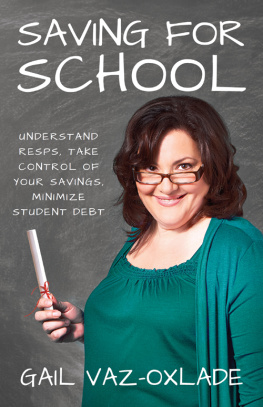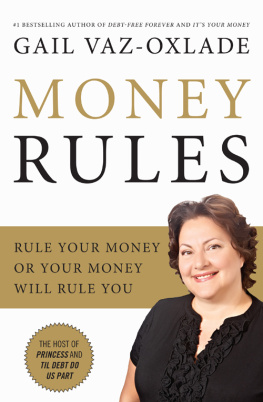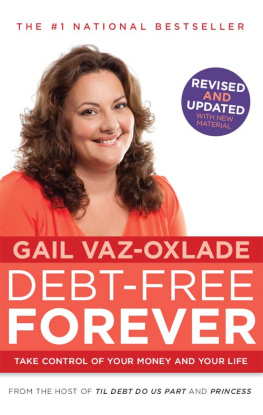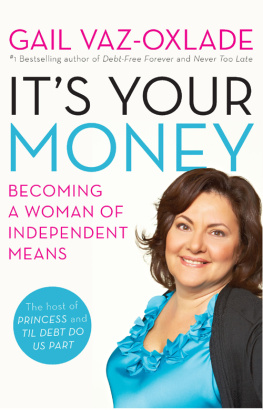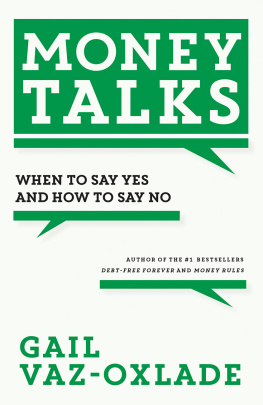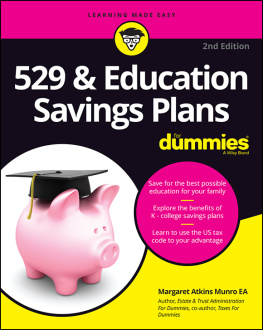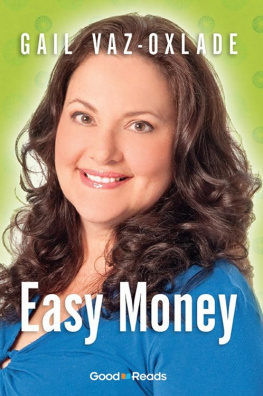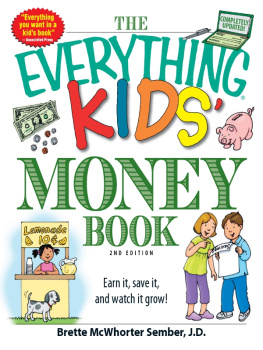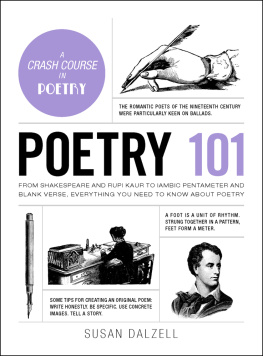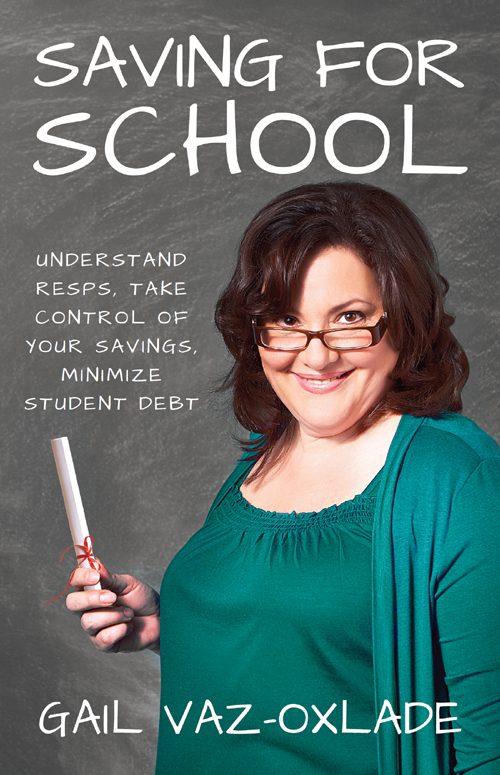SAVING
FOR
SCHOOL
Understand RESPs, Take Control of Your
Savings, Minimize Student Debt
Gail Vaz-Oxlade

To the young uns in my life who listened carefully.
Im honoured to have been able to guide you.
I love you all tremendously and am so proud of how nicely youve grown up.
Im not sure why it is that so many people refuse to take free money. Free isnt often really free, and when it is, we should be leaping at the opportunity. Maybe you just dont know that the government wants to GIVE you money for your childs future education. Maybe you dont believe that free is really free. Or maybe youre so unsure of how to get the free money, youve yet to take action. Let me assure you that a Registered Education Savings Plan (RESP) is a fabulous way to save for school. And, yes, you get free money if you follow the rules. So please, please, do not turn your back on this opportunity to help your son or daughter. Opportunities like this are few and far between and this is your chance to take full advantage of free.
It seems like a lifetime ago that my children were born. I was 34 when I had Alexandra and almost 37 when Malcolm came along. My children changed everything about my life: where I lived, how I worked, when I worked, what I did with my spare time. Ha! Spare time was a thing of the past, as was spare money.
Being self-employed meant that when I went on maternity leave, there was no money from the employment insurance system. I had to have a stash of cash in the bank to take care of my share of the household bills. But even though there wasnt much money to spare, as soon as Alex was born, I started putting money away for her post-secondary education. Id seen the stats about what it would cost; it turned out they underestimated.
There are three ways to pay for post-secondary education: (1) save the money while the kids are young, (2) come up with the money each year as your child goes through school, and (3) borrow.
Since Im of a savings mind and was strongly committed to ensuring the funds were available should my kids decide to pursue a higher education, I saved. Alexs undergrad degree cost about $18,000 a yearthats $72,000 for a four-year degree. Half of that was tuition. The rest went to books, lab fees, housing, utilities, Internet, food, transportation, clothes and the like.
Lest you think that Alex lived a high-style life while at university, let me describe the house she shared. Imagine a regular-sized two-bedroom home with a sunroom and a finished basement. Sounds nice, doesnt it? Now imagine that every single room in the houseexcept the two kitchens and two bathroomshas been turned into a bedroom. Alex had six roommates in that small two-bedroom house. Seven kids shared two bathrooms and two kitchens. Were not talking cushy here.
Had I used the RESP money alone to see Alex through her undergrad, we would have blown through all the money before the end of year three. I wanted to be sure she didnt graduate with an albatross of debt around her neck. Thats a hell of a way to start a life. So I paid for her housing expenses out of my cash flow and used her RESP for all things school-related, like tuition and books.
Coming up with the money from cash flow doesnt have to all fall on a parents shoulders. Kids have a role to play in picking up a part of the tab for their own education. But there are some programs that are so intensive that working while in school is impossible. And of late, the summer job landscape has been bleak. So university and college students are taking on debt at a wicked clip to complete their degrees.
While student debt is considered good debt, that only holds true if you dont take on too much and can pay it back quickly. Many people are unaware that the default student-loan minimum payment will keep a body in debt for almost 10 years. And since the interest rate on student loans is no great dealits actually higher than what youd pay to a regular lender to offset the interest-free period while students are in schoolthat default minimum can mean huge interest costs.
Graduates are coming out of school with record levels of debt. According to the Canadian Federation of Students, the average debt for university graduates is almost $27,000. Lest you think that doesnt sound like so much, let me point out thats an average. Since there are many kids graduating without any debt at all, because their parents had the foresight to save and could afford to help, those who do have debt have far more debt than the average would indicate. Did you know that the Canada Student Loans Program is close to hitting its $15-billion threshold years in advance? Thats a direct result of the fact that the cost of getting an education has gone up disproportionately to inflation. And the trend shows no sign of reversing.
It doesnt take a huge amount of money to make a difference if you put enough time on your side. I started with $100 a month. Every month, I had that amount debited from my chequing account and moved over to an account for Alex. When Malcolm came along, I did exactly the same thing. And the counter just ticked along, month after month.
When I first opened post-secondary savings accounts for my children, I did not use the RESP. At the time, the restrictions on what the money could be used for were much tighter than those of todays RESPs. Group RESPs were much more popular than bank-run RESPs, and I didnt want to get stuck in a system that provided so little flexibility. What if I had a tough month or two? What if one of the kids decided not to go further than high school? I wasnt prepared to forgo my hard-earned money. And I hate penalties and fees!
When the legislation changed and RESPs became the fabulous education savings plans they are now, I jumped on them. I had years of catching up to do and I got busy.
One of the things that made the new-and-improved RESP so attractive was the introduction of the Canada Education Savings Grant (CESG). This is FREE MONEY that the government gives to families as an incentive to save for their childrens future education. When you put $100 into an RESP for an eligible child, the government gives you $20. Thats right, GIVES you. Thats like getting 20% interest on your money without having to do a thing. It boggles my mind that every single parent doesnt have an RESP for each of their children. Who turns their back on free money?
More than half of Canadians do. Lord love a duck! As of the end of 2010 (the last year for which Statistics Canada published numbers), less than 43% of those children who were eligible for the CESG were getting it.
Parents, you cant complain about how much school is costing your kids, how much debt your children will graduate with or how hard it is to find money to save if youre prepared to turn your back on free money. No one says you have to start by maxing out the RESP every year. I didnt. On a maternity leave budget with very little cash to spare, all I could come up with was $100 a month. If you can only swing $50, so be it. That works out to about $1.67 a day, or one cup of not-very-expensive drive-through coffee. Is your childs future worth $1.67 to you?
You can plan now or pay later. Or you can do nothing and hope your children can work their way through university or get good enough jobs to get their debt paid off lickety-split. School costs are only going to keep going up.
When Alex was a baby, the projected cost for her four-year degree was $42,000. That number is burned in my memory because I so vividly remember thinking, How the hell am I going to get to $42,000 in savings? Turns out, the projections were on the low side, but the magic of compounding return did its job. I got to the $42,000 plus some with diligent savings and good returns on my investments.

